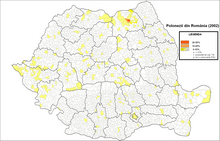Poles in Romania
 Poles in Romania (2002 census) | |
| Total population | |
|---|---|
| 2,543[citation needed] (2011) | |
| Regions with significant populations | |
| Suceava County | |
| Languages | |
| Polish, Romanian | |
| Religion | |
| majority Roman Catholicism | |
| Related ethnic groups | |
| Polish diaspora |
According to the 2011 census, 2,543 Poles live in Romania, mainly in the villages of Suceava County (Polish: Suczawa). There are three exclusively Polish villages: Nowy Sołoniec (Solonețu Nou), Plesza (Pleșa) and Pojana Mikuli (Poiana Micului), as well a significant Polish presence in Kaczyca (Cacica) and Paltynosa (Păltinoasa). Poles in Romania form an officially recognised national minority, having one seat in the Chamber of Deputies of Romania (currently held by the Union of Poles of Romania) and access to Polish elementary schools and cultural centres (known as "Polish Houses").[citation needed]
History[]
| Year | Pop. | ±% |
|---|---|---|
| 1930 | 48,310 | — |
| 1948 | 6,753 | −86.0% |
| 1956 | 7,627 | +12.9% |
| 1966 | 5,860 | −23.2% |
| 1977 | 4,641 | −20.8% |
| 1992 | 4,232 | −8.8% |
| 2002 | 3,559 | −15.9% |
| 2011 | 2,543 | −28.5% |
| Official census data | ||
The first Poles settled in Moldavia in the times of Casimir III (specifically during the Late Middle Ages). Most of the Poles immigrating after 1774 were looking for work. So it was that Polish miners from Bochnia and Wieliczka were brought to salt mines in Cacica. Another wave of Polish immigration arrived in Bukovina in the early 19th century, when the region was a crownland of the Austro-Hungarian Empire, as was a significant portion of present-day southern Poland (see: Kingdom of Galicia and Lodomeria).[citation needed]
Around 1803, Polish highlanders from Čadca (Polish: Czaca, Czadca) settled in Treblecz (Tereblecea) by Siret, in Stara Huta Krasna and in Kaliczanka and again in 1814 to 1819, this time settling in Hliboka (Adâncata) and Tereszna. Nowy Sołoniec was settled in 1834, Plesza in 1835 and Pojana Mikuli in 1842. At that time, Bukovina was a very attractive place to live in because of Austria's policy not to conscript recruits into its army from there (service in the Austrian army at that time was for a 14-year term). Moreover, Bukovina was free from serfdom, attracting immigrants of German (Bukovina Germans), Jewish, Czech, Slovak, Russian, Italian, and Polish nationality.[citation needed]
There were probably other waves of migration from Poland after the November and Kraków Uprisings, but most Poles were from peasant families relocated there by the Empire's authorities after they participated in the Jakub Szela insurrection.[citation needed]
Communes with the highest Polish population percentage[]

- Suceava County
- Cacica — 20.04%
- Mănăstirea Humorului — 19.3%
- Mușenița — 4.06%
- Moara — 3.23%
- Păltinoasa — 1.14%
Notable Polish Romanians[]
- Corneliu Zelea Codreanu, politician, founder of the Iron Guard
- Ioan Gyuri Pascu (partly Polish), musician, actor, and comedian
- Octavian Smigelschi (partly Polish), painter
- Stefan Norris (born in Poland; subsequently settled in Romania), art director
- Mărgărita Miller-Verghy, author, journalist, critic, and translator
- Wojciech Weiss, painter
- Leonard Mociulschi, major general
- Henri Cihoski, lieutenant-general
- Robert Sadowski, international footballer
- Michał Belina-Czechowski, Seventh-Day Adventist preacher
- Ghervazen Longher, politician
- , politician
- , physician
- , Roman Catholic vicar and publisher
- , physician
- , cartoonist and academic
- , Roman Catholic priest and schoolteacher
Gallery[]

The Polish House in Suceava (Dom Polski w Suczawie), built at the round of the 20th century (between 1903 and 1907)
Polish newspaper in Romania

The salt mine in Cacica, Suceava county, southern Bukovina

Roman Catholic basilica in Cacica
See also[]
- Polish–Romanian alliance
- Romanian Bridgehead
- Poland-Romania relations
- Polonia Cernăuți
- Poles in Moldova
- Poles in Hungary
- Polish diaspora
External links[]
| Wikimedia Commons has media related to Polish minority in Romania. |
- Map of Polish villages in Romania
- (in Polish) Polonia w Rumunii
- (in Polish and Romanian) Polscy uchodźcy w Rumunii 1939–1947. Dokumenty z Narodowych Archiwów Rumunii / Refugiații polonezi în România 1939–1947. Documente din Arhivele Naționale ale României, t. 1, cz. 1 i 2[permanent dead link]*The Polish organization in Romania
- Polish minority in Cacica - Romania (archive)
- Poles in Romania
- Bukovina
- Ethnic groups in Romania
- Polish minorities
- Romanian people of Polish descent
- Poland–Romania relations




